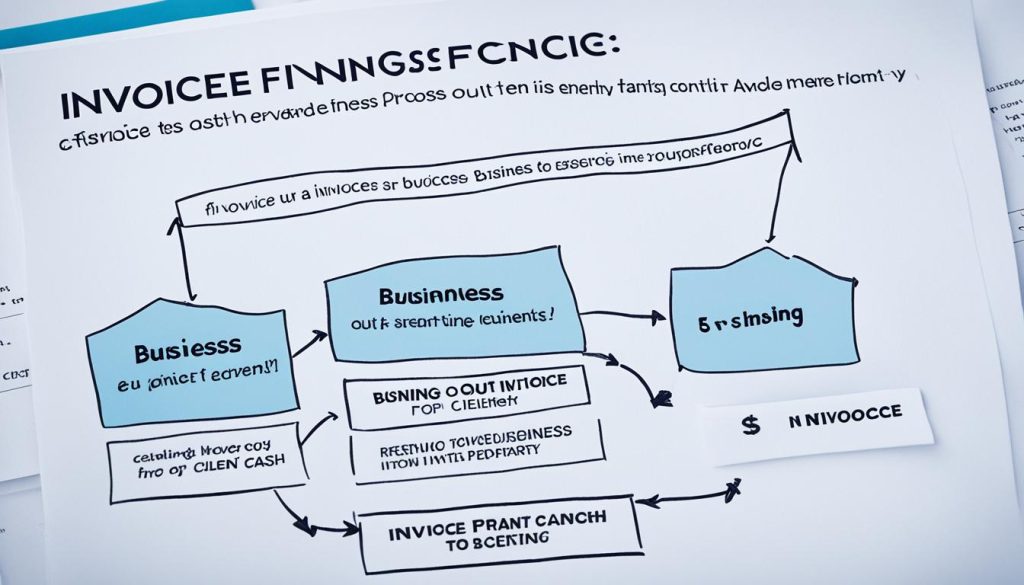Welcome to our comprehensive guide on invoice finance, where we will explain the meaning of invoice finance and delve into its ins and outs. If you’re a business owner looking for a quick and convenient way to access funds, invoice finance could be the solution for you. So, let’s get started and explore the world of invoice finance!
Throughout this guide, we will explore the various types of invoice finance, discuss the benefits it offers to businesses, and provide guidance on how to obtain invoice finance for your business. Stay tuned for more insights!
What is Invoice Finance?
Invoice finance is a financial tool that allows businesses to improve cash flow by using unpaid invoices as collateral to secure a loan or cash advance from a lender. It’s a common practice in the UK for businesses that experience long payment terms or cash flow gaps. There are two main types of invoice finance: invoice factoring and invoice discounting.
With invoice factoring, a business sells its invoices to a third-party finance provider, known as a factor, who then collects payment directly from the business’s customers. Invoice discounting, on the other hand, allows a business to borrow money against its unpaid invoices but retains control over collecting payments from customers.
Overall, invoice finance can be a valuable tool for businesses looking to manage their cash flow more effectively and reduce the impact of late payments.
How Does Invoice Financing Work?
Invoice financing provides businesses with immediate cash flow by selling their unpaid invoices to a third-party lender. This process involves two key steps: invoice submission and fund disbursement.
Invoice Submission
When using invoice financing, a business submits its outstanding invoices to a lender. These invoices represent the amounts owed by customers for products or services provided. The lender evaluates the creditworthiness of the business’s customers and determines the maximum advance percentage it can offer.
Once the lender approves the invoices, the business submits them electronically or provides physical copies. The lender verifies the invoices and assesses their eligibility based on factors such as authenticity, completeness, and payment terms. This stage is vital to ensure the accuracy and legitimacy of the invoices being financed.
After the verification process, the lender notifies the business of the approved funding amount. Typically, the lender provides an advance of around 80-90% of the total invoice value, which offers the business immediate access to cash flow.
Fund Disbursement
After the invoice submission process, the lender manages the payment collection from the business’s customers. There are two main types of invoice financing: factoring and discounting.
In factoring, the lender takes over the responsibility for collecting payment from the customers. The lender directly interacts with the customers, ensuring efficient and timely collections. Once the customers pay their invoices, the lender deducts its fees, including financing charges, and disburses the remaining balance to the business.
On the other hand, discounting allows the business to retain the responsibility for collecting payment from its customers. The lender provides the advance against the invoices, but the business manages the collection process. When the customers pay, they directly remit the payment to the lender. Similar to factoring, the lender deducts its fees and transfers the remaining funds to the business.
Both factoring and discounting options in invoice financing provide businesses with the necessary cash flow to support their operations. The choice between the two depends on factors such as the nature of the business, customer relationships, and collection capabilities.

Is Invoice Finance Right for Your Business?
Invoice finance can be a valuable solution for businesses that depend on prompt invoice payments to maintain their cash flow. It is particularly advantageous for small and medium-sized businesses that experience extended payment cycles or seasonal fluctuations in cash flow. By leveraging their unpaid invoices, these businesses can access the funds they need to cover operational expenses, invest in growth opportunities, or bridge temporary gaps in cash flow.
However, it’s essential to consider various factors before deciding if invoice finance is the right choice for your business. While it offers benefits, such as quick access to funds and improved cash flow, it may not be the most cost-effective option in the long run. Fees associated with invoice finance can sometimes be higher than those of traditional bank loans. Therefore, it’s crucial to carefully evaluate the potential costs involved and compare them with other financing options.
Additionally, it’s important to assess your business’s specific needs and circumstances. For small businesses with limited access to credit or a history of slow-paying customers, invoice finance can provide a valuable lifeline. It can help bridge the gap between delivering goods or services and receiving payment, ensuring that your business has the necessary funds to continue operations smoothly.
When considering invoice finance, it’s also worth exploring other funding alternatives, such as lines of credit or business loans. Each financing option has its benefits and drawbacks, so it’s crucial to assess which one aligns best with your business goals, financial situation, and risk tolerance.
Who Needs Invoice Financing?
Invoice financing can benefit a range of businesses across various industries. Here are some scenarios where invoice finance might be a good fit:
- Small and medium-sized businesses with limited access to credit from traditional lenders
- Businesses experiencing seasonality in their cash flow
- Companies that rely on a few key customers for the majority of their revenue
- Startups and growing businesses that need to invest in expansion or new opportunities
- Businesses that face lengthy payment cycles and need to cover expenses while awaiting customer payments
Overall, invoice finance offers flexibility and convenience for businesses seeking to optimize their cash flow management. By leveraging their unpaid invoices, businesses can access funds quickly, enabling them to focus on growth and operations. However, it’s crucial to carefully evaluate the costs and benefits of invoice finance, considering your business’s unique circumstances and exploring alternative financing options.

Types of Invoice Finance
When it comes to invoice finance, there are two main types that businesses can utilize: factoring and discounting. Each type offers unique benefits and considerations, so it’s important to understand the differences and choose the right one for your business needs.
Factoring:
Factoring involves selling the entire value of your unpaid invoices to an invoice finance company. The finance company then takes over the responsibility of collecting payment from your customers. This type of invoice finance is especially beneficial if you prefer to offload the task of chasing payments, as it allows you to focus on other areas of your business.
Discounting:
Unlike factoring, discounting allows you to retain control over collecting payment from your customers. With discounting, you borrow against the value of your invoices and use them as collateral for a loan from an invoice finance company. This type of finance is ideal if you have an efficient payment collection process in place and want to maintain a direct relationship with your customers.
Now that you understand the two main types of invoice finance, it’s time to choose the best option for your business. There are several invoice finance companies in the market, each offering different terms and options. It’s essential to compare and evaluate various providers to find the one that aligns with your unique requirements.
| Types of Invoice Finance | Responsibility for Collecting Payment | Main Benefit |
|---|---|---|
| Factoring | Invoice finance company collects payment from customers | Offloads the task of chasing payments |
| Discounting | Business retains responsibility for collecting payment | Maintains a direct relationship with customers |

Benefits of Invoice Finance for Businesses
Invoice finance offers several benefits to businesses. It provides quick and convenient access to funds, improves cash flow, and does not require collateral or a lengthy application process. Through invoice finance, businesses can receive upfront funds for their unpaid invoices, eliminating the need to wait for customer payments. This allows for increased financial flexibility and the ability to meet immediate business needs or investments.
Unlike traditional loans, invoice finance does not incur any debt. It is not a loan, but a method of leveraging unpaid invoices to access the cash tied up in them. This means that businesses can benefit from quick funding without taking on additional financial obligations.
Another advantage of invoice finance is its flexibility. Businesses can choose between factoring and discounting, depending on their specific circumstances and preferences. Factoring involves selling the entire value of the invoice to the lender, who then takes over the responsibility of collecting payment from the customer. Discounting, on the other hand, allows businesses to retain the responsibility for collecting payment while borrowing against the value of the invoice. This flexibility allows businesses to tailor the invoice finance solution to their individual needs.
Additionally, invoice finance can reduce the risk of non-payment. Some invoice finance providers offer bad debt protection as part of their services. This means that if a customer fails to pay the invoice, the lender may cover a portion or all of the unpaid amount, protecting the business from potential financial losses.
Overall, the benefits of invoice finance include improved cash flow, quick access to funds, flexibility, and reduced risk. It is a valuable financial tool for businesses looking to optimize their working capital and overcome the challenges of late payments.
| Benefits of Invoice Finance | Description |
|---|---|
| Quick and Convenient Access to Funds | Invoice finance provides businesses with immediate access to funds without the need for collateral or a lengthy application process. |
| Improved Cash Flow | By receiving upfront funds for unpaid invoices, businesses can improve their cash flow and meet immediate financial needs. |
| No Debt Incurred | Invoice finance is not a loan, so it does not involve taking on additional debt. |
| Flexibility | Businesses can choose between factoring and discounting to tailor the invoice finance solution to their specific requirements. |
| Reduced Risk | Some invoice finance providers offer bad debt protection, minimizing the risk of non-payment by customers. |
How to Get Invoice Finance for Your Business?
Getting invoice finance for your business is a straightforward process that can provide a boost to your cash flow. Follow these steps to secure invoice financing and accelerate your business growth:
1. Research Invoice Financing Companies
Start by researching different invoice financing companies to find the one that best suits your business’s needs. Consider their eligibility criteria, pricing, and additional features. Look for reputable companies that specialize in providing invoice financing solutions.
2. Understand the Application Process
Familiarize yourself with the application process of each invoice financing company. Take note of the required documents and information you’ll need to provide. Common requirements include outstanding invoices from customers and proof of your business’s financial stability.
3. Gather Necessary Documents
Gather all necessary documents, such as financial statements, payment history, and any other relevant paperwork that strengthens your application. Having these documents ready will speed up the process and increase your chances of approval.
4. Complete the Application
Complete the application form provided by the invoice financing company. Fill in all required fields accurately and provide any additional information that may support your application. Double-check for any errors or missing information before submitting.
5. Review Terms and Conditions
Once you receive an offer from an invoice financing company, carefully review the terms and conditions of the financing agreement. Pay attention to the fees, repayment terms, and any other conditions that may impact your business. Ensure that the terms align with your business’s financial goals and objectives.
6. Sign the Agreement
If you’re satisfied with the terms and conditions, sign the agreement to formalize the invoice financing arrangement. Make sure you understand the rights and responsibilities of both parties and seek legal advice if necessary.
By following these steps, you can successfully obtain invoice finance for your business and unlock the benefits of improved cash flow and accelerated growth.

| Benefits of Getting Invoice Finance | How Invoice Finance Works | Invoice Financing Companies |
|---|---|---|
| 1. Quick and convenient access to funds | 1. Selling unpaid invoices to a lender | 1. Company A |
| 2. Improved cash flow | 2. Advancing a percentage of invoice value | 2. Company B |
| 3. No debt incurred | 3. Lender deducts fees and returns balance | 3. Company C |
| 4. Flexible financing options | 4. Factoring and discounting | 4. Company D |
| 5. Reduced risk of non-payment | 5. Bad debt protection | 5. Company E |
Potential Drawbacks and Considerations in Invoice Finance
While invoice finance offers many benefits, it is important to consider some potential drawbacks before opting for this financing solution. One key consideration is the fees associated with invoice finance. In comparison to traditional bank loans, the fees can be higher, which may make invoice finance a less cost-effective option in the long run.
Another factor to consider is concentration limits that some lenders impose in invoice finance. These limits may affect businesses with a higher debtor concentration, as some lenders may be averse to financing such businesses. It is crucial to review these concentration limits and understand if they align with your business’s specific financial situation.
When exploring invoice finance options, carefully reviewing the terms and conditions is essential. It’s important to understand any recourse provisions and fully comprehend all fees associated with the agreement. Taking the time to go through these details will help you make an informed decision about whether invoice finance is the right choice for your business.
Conclusion
In conclusion, understanding what invoice finance entails is crucial for businesses seeking to enhance their cash flow management. As discussed, this financial practice involves using outstanding invoices as collateral to secure funding, providing a way to access cash tied up in unpaid invoices. With options like factoring and discounting, businesses can choose the approach that best suits their needs, whether they prefer to outsource the collection of invoices or retain control over customer relationships.
By leveraging invoice finance, businesses can bridge the gap between invoicing and receiving payments, helping them to maintain operations, invest in growth, and manage day-to-day expenses more effectively. While it’s essential to weigh the costs and benefits, invoice finance can be a valuable tool for businesses of all sizes, offering a flexible and accessible source of funding to support their financial needs.
FAQs
What are the types of invoice finance?
There are two main types of invoice finance: factoring and discounting. Factoring involves selling the entire value of the invoice to the lender, who takes over the responsibility of collecting payment from the customer. Discounting involves borrowing against the value of the invoice, with the business retaining responsibility for collecting payment.
What are the benefits of invoice finance for businesses?
Invoice finance offers several benefits to businesses. It provides quick and convenient access to funds, improves cash flow, and does not incur any debt. It offers flexibility, bad debt protection in some cases, and helps reduce the risk of non-payment.
Is invoice finance a good idea?
Invoice finance can be a beneficial tool for businesses looking to improve cash flow by accessing funds tied up in unpaid invoices. It can help with working capital needs and provide flexibility in managing finances.
Is invoice financing risky?
While invoice financing can help businesses manage cash flow, there are risks involved, such as potential dependency on this form of financing, added costs in terms of fees and interest rates, and concerns over customer relationships if a third party is involved in collecting payments.
What is the difference between trade finance and invoice finance?
Trade finance typically refers to financing the import/export of goods and services, including activities like supply chain financing and export credit. On the other hand, invoice finance involves obtaining funds against unpaid invoices to improve cash flow.
What is the interest rate for invoice financing?
The interest rates for invoice financing can vary depending on the provider, the terms of the agreement, and the creditworthiness of the business. Rates are usually determined based on factors like the invoice amount, repayment terms, and the risk associated with the transaction.
How much is invoice finance?
The cost of invoice finance can vary based on factors like the provider’s fees, the amount of the invoice, the creditworthiness of the business, and the terms of the agreement. Typically, fees can range from 1-5% of the invoice value.
What industries use invoice finance?
Various industries utilize invoice finance to improve cash flow and manage working capital effectively. Common industries that use invoice finance include manufacturing, construction, transportation, staffing agencies, IT services, and other businesses that operate on a B2B basis.





